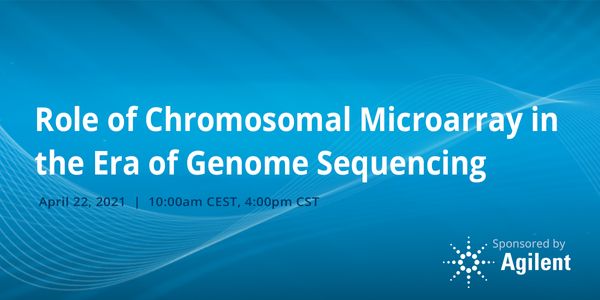Genomics
Genomics: an interdisciplinary field of science within the field of molecular biology. A genome is a complete set of DNA within a single cell of an organism, and as such, focuses on the structure, function, evolution, and mapping of genomes. Genomics aims at the collective characterization and quantification of genes, which direct the production of proteins with the assistance of enzymes and messenger molecules. Genomics also involves the sequencing and analysis of genomes.
-
APR 22, 2021 | 7:30 AMPharmacogenomics has had rapid implementation over the past decade, with recent growth in application in oncology, mental health, solid organ transplantation, and more. There has been much f...APR 22, 2021 | 6:00 AMAs NGS panels grow, test interpretation becomes more complex and time-consuming / With the explosion of NGS data, the need for consolidated databases with reliable and transparent curation a...Speaker: Dominic John , Simon Forbes, PhD , Shawn Bauer , Lisa Barrow-LaingAPR 22, 2021 | 10:00 AMDate: April 22, 2021 Time: 10:00am (CEST), 4:00pm (CST) Advancements in technologies have revolutionized the genetic landscape. Chromosomal microarray analysis (CMA) becomes a proven method...APR 22, 2021 | 12:00 AMLaboratory implementation of clinical genomics in children requires customization of analytical tools tailored to profile the divergent mutational landscape in childhood tumors. The relative...APR 22, 2021 | 12:00 AMLearning Objectives: 1. Identify different kinds of genomic resources 2. Learn to apply the features available in genomic resources to cancer variant interpretation 3. Describe the importanc...APR 21, 2021 | 9:00 AMSingle-cell gene expression analysis helps biologists and bioinformaticians reveal complex and rare cell populations, uncover regulatory relationships among genes and analyze and visualize g...Speaker: Joseph Pearson, PhDAPR 21, 2021 | 7:30 AMThe SARS-CoV-2 pandemic is challenging our health care systems and has profoundly impacted our society. Due to the poor global public health response, SARS-CoV-2 has developed many variants....Speaker: Eric Allen, MBA, M. Eng. Bioengineering , Michael Oberholzer, PhDPresented at: Genetics Week Virtual Event Series 2021
APR 21, 2021 | 6:00 AMControlling the spread of the 2019 novel coronavirus SARS-CoV-2 and ensuring a return to 'normal' activities in a post-COVID world requires two complementary efforts: 1) Widespread a...APR 21, 2021 | 12:00 AMAs part of Healthy Davis Together, we have implemented rapid, inexpensive, high throughput testing for SARS-Cov-2 using technology repurposed from the agricultural biotechnology sector. This...APR 21, 2021 | 12:00 AMAs the SARS-CoV-2 continues to spread and evolve and vaccination efforts are under way, countries around the world are confronting new public health challenges due to the emergence and rapid...APR 21, 2021 | 12:00 AMAccording to the American Cancer Society, in there were an estimated 110,070 new cases diagnosed and approximately 32,120 deaths from gynecologic cancers in the U.S. in 2018. Of the five mos...APR 21, 2021 | 12:00 AMAs viral threats continue to emerge, viral detection assays are important not only for recognizing if a virus is present, but also for surveillance and variant characterization. Accurate det...APR 20, 2021 | 4:30 PMInterest in cell and gene therapy-based disease prevention and treatment has increased rapidly over the last few decades, however there are still many hurdles to overcome and further progres...Speaker: Andrea O'Hara, PhDAPR 20, 2021 | 4:30 PMC.E. CREDITSCOVID-19 is a severe disease that has caused >1 million deaths in under one year. As this disease is novel, the molecular and cellular underpinnings of the progressive tissue injury are p...Speaker: Christopher Mason, Ph.DAPR 20, 2021 | 3:00 PMBridging a deep understanding of molecular profiles with clinical information is critical to developing innovative precision medicine tools in oncology. Discovery’s recently launched S...Speaker: Nathan Henson, MS , Donald Skifter, PhD, MBAAPR 20, 2021 | 1:30 PMRevolutionary sequencing technologies are enabling whole transcriptome profiling of tens to hundreds of thousands of single cells in parallel, in a single experiment. This has led to an expl...Speaker: Carina Emery , Alina SteinbachAPR 20, 2021 | 12:00 PMNanoCellect will discuss the importance of cell sample preparation in order to obtain good quality sequencing data with 3’ RNA-Seq as well as cell sample preparation in order to obtain...Speaker: Nicole Jagnandan, PhDAPR 20, 2021 | 9:00 AMChromatin Immunoprecipitation, coupled with sequencing, has shaped our understanding of how transcriptional machinery interacts with genomes to facilitate gene regulation. These protein-DNA...Speaker: Cory Padilla, PhDAPR 20, 2021 | 5:00 PMDate: April 20, 2021 Time: 8:00am (PDT), 11:00am (EDT), 5:00pm (CEST) Spatial Answers on Oncology - Professor Joan Seoane Prof. Joan Seoane, Group Leader and Director of the Translational Re...Speaker: Noel De Miranda , Vasilis Stavrinides, MDSponsored By: NanoString Technologies, IlluminaAPR 20, 2021 | 7:30 AMC.E. CREDITSStructural variants (SVs) are essential in human evolution and genetic disease but remain understudied. This is especially the case for non-Caucasian ethnicities. We report, for the first ti...APR 20, 2021 | 6:00 AMSince late 2020, several prominent SARS-CoV-2 variants of concern have emerged harboring specific mutations which increase viral transmissibility (e.g., lineage B.1.1.7), and which appear to...Speaker: Brian Dugan, M.S. , Fernando Spikli, PhDAPR 20, 2021 | 12:00 AMSex and gender differences are apparent in health and disease and aduring aging. Chronic obstructive pulmonary disease is a leading cause of death with pronounced sex and gender differences...APR 20, 2021 | 12:00 AMC.E. CREDITSWe are entering into an exciting era of genomics where truly complete, high-quality assemblies of human chromosomes are available end-to-end, or from ‘telomere-to-telomere’ (T2T)...APR 20, 2021 | 12:00 AMTelomere length (TL) is widely considered a molecular/cellular hallmark of the aging process with implications for multiple diseases. While there has been success in epidemiology and genomew...
APR 22, 2021 | 7:30 AM
Pharmacogenomics has had rapid implementation over the past decade, with recent growth in application in oncology, mental health, solid organ transplantation, and more. There has been much f...
APR 22, 2021 | 6:00 AM
As NGS panels grow, test interpretation becomes more complex and time-consuming / With the explosion of NGS data, the need for consolidated databases with reliable and transparent curation a...
Speaker:
Dominic John
, Simon Forbes, PhD
, Shawn Bauer
, Lisa Barrow-Laing
APR 22, 2021 | 10:00 AM
Date: April 22, 2021 Time: 10:00am (CEST), 4:00pm (CST) Advancements in technologies have revolutionized the genetic landscape. Chromosomal microarray analysis (CMA) becomes a proven method...
APR 22, 2021 | 12:00 AM
Laboratory implementation of clinical genomics in children requires customization of analytical tools tailored to profile the divergent mutational landscape in childhood tumors. The relative...
APR 22, 2021 | 12:00 AM
Learning Objectives: 1. Identify different kinds of genomic resources 2. Learn to apply the features available in genomic resources to cancer variant interpretation 3. Describe the importanc...
APR 21, 2021 | 9:00 AM
Single-cell gene expression analysis helps biologists and bioinformaticians reveal complex and rare cell populations, uncover regulatory relationships among genes and analyze and visualize g...
Speaker:
Joseph Pearson, PhD
APR 21, 2021 | 7:30 AM
The SARS-CoV-2 pandemic is challenging our health care systems and has profoundly impacted our society. Due to the poor global public health response, SARS-CoV-2 has developed many variants....
Speaker:
Eric Allen, MBA, M. Eng. Bioengineering
, Michael Oberholzer, PhD
Presented at: Genetics Week Virtual Event Series 2021
APR 21, 2021 | 6:00 AM
Controlling the spread of the 2019 novel coronavirus SARS-CoV-2 and ensuring a return to 'normal' activities in a post-COVID world requires two complementary efforts: 1) Widespread a...
APR 21, 2021 | 12:00 AM
As part of Healthy Davis Together, we have implemented rapid, inexpensive, high throughput testing for SARS-Cov-2 using technology repurposed from the agricultural biotechnology sector. This...
APR 21, 2021 | 12:00 AM
As the SARS-CoV-2 continues to spread and evolve and vaccination efforts are under way, countries around the world are confronting new public health challenges due to the emergence and rapid...
APR 21, 2021 | 12:00 AM
According to the American Cancer Society, in there were an estimated 110,070 new cases diagnosed and approximately 32,120 deaths from gynecologic cancers in the U.S. in 2018. Of the five mos...
APR 21, 2021 | 12:00 AM
As viral threats continue to emerge, viral detection assays are important not only for recognizing if a virus is present, but also for surveillance and variant characterization. Accurate det...
APR 20, 2021 | 4:30 PM
Interest in cell and gene therapy-based disease prevention and treatment has increased rapidly over the last few decades, however there are still many hurdles to overcome and further progres...
Speaker:
Andrea O'Hara, PhD
APR 20, 2021 | 4:30 PM
C.E. CREDITS
COVID-19 is a severe disease that has caused >1 million deaths in under one year. As this disease is novel, the molecular and cellular underpinnings of the progressive tissue injury are p...
Speaker:
Christopher Mason, Ph.D
APR 20, 2021 | 3:00 PM
Bridging a deep understanding of molecular profiles with clinical information is critical to developing innovative precision medicine tools in oncology. Discovery’s recently launched S...
Speaker:
Nathan Henson, MS
, Donald Skifter, PhD, MBA
APR 20, 2021 | 1:30 PM
Revolutionary sequencing technologies are enabling whole transcriptome profiling of tens to hundreds of thousands of single cells in parallel, in a single experiment. This has led to an expl...
Speaker:
Carina Emery
, Alina Steinbach
APR 20, 2021 | 12:00 PM
NanoCellect will discuss the importance of cell sample preparation in order to obtain good quality sequencing data with 3’ RNA-Seq as well as cell sample preparation in order to obtain...
Speaker:
Nicole Jagnandan, PhD
APR 20, 2021 | 9:00 AM
Chromatin Immunoprecipitation, coupled with sequencing, has shaped our understanding of how transcriptional machinery interacts with genomes to facilitate gene regulation. These protein-DNA...
Speaker:
Cory Padilla, PhD
APR 20, 2021 | 5:00 PM
Date: April 20, 2021 Time: 8:00am (PDT), 11:00am (EDT), 5:00pm (CEST) Spatial Answers on Oncology - Professor Joan Seoane Prof. Joan Seoane, Group Leader and Director of the Translational Re...
Speaker:
Noel De Miranda
, Vasilis Stavrinides, MD
Sponsored By: NanoString Technologies,
Illumina
APR 20, 2021 | 7:30 AM
C.E. CREDITS
Structural variants (SVs) are essential in human evolution and genetic disease but remain understudied. This is especially the case for non-Caucasian ethnicities. We report, for the first ti...
APR 20, 2021 | 6:00 AM
Since late 2020, several prominent SARS-CoV-2 variants of concern have emerged harboring specific mutations which increase viral transmissibility (e.g., lineage B.1.1.7), and which appear to...
Speaker:
Brian Dugan, M.S.
, Fernando Spikli, PhD
APR 20, 2021 | 12:00 AM
Sex and gender differences are apparent in health and disease and aduring aging. Chronic obstructive pulmonary disease is a leading cause of death with pronounced sex and gender differences...
APR 20, 2021 | 12:00 AM
C.E. CREDITS
We are entering into an exciting era of genomics where truly complete, high-quality assemblies of human chromosomes are available end-to-end, or from ‘telomere-to-telomere’ (T2T)...
APR 20, 2021 | 12:00 AM
Telomere length (TL) is widely considered a molecular/cellular hallmark of the aging process with implications for multiple diseases. While there has been success in epidemiology and genomew...
























